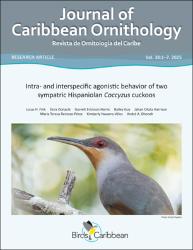Mostrar el registro sencillo del ítem
Intra- and interspecific agonistic behavior of two sympatric Hispaniolan Coccyzus cuckoos
| Licencia | Open Access article distributed under the Creative Commons Attribution License BY 4.0, which permits unrestricted use, distribution, and reproduction, provided the original work is properly cited. | es |
| Autor | Fink, Lucas H. | |
| Autor | Donacik, Dora | |
| Autor | Erickson-Harris, Garrett | |
| Autor | Guy, Bailey | |
| Autor | Okata Harrison, Jahan | |
| Autor | Reinoso-Pérez, María Teresa | |
| Autor | Navarro-Vélez, Kimberly | |
| Autor | Dhondt, André A. | |
| Fecha de admisión | 2025-05-06T01:38:34Z | |
| Fecha disponible | 2025-05-06T01:38:34Z | |
| Año | 2025 | |
| Citación | Fink, L. H., Donacik, D., Erickson-Harris, G., Guy, B., Harrison, J. O., Reinoso-Pérez, M. T., ... & Dhondt, A. A. (2025). Intra-and interspecific agonistic behavior of two sympatric Hispaniolan Coccyzus cuckoos. Journal of Caribbean Ornithology, 38, 1-7. Recuperado de: | es |
| URI | https://bvearmb.do/handle/123456789/6172 | |
| Sinopsis | Abstract: Coccyzus longirostris (the Hispaniolan Lizard-Cuckoo) and C. minor (the Mangrove Cuckoo) coexist in various habitats on Hispaniola. Little is known about how, or even whether, the two species interact there. This study used acoustical playback experiments and observations to investigate the aggressive behavior of these two cuckoo species in Punta Cana, Dominican Republic to test the hypotheses that (1) both species are territorial and hence respond aggressively to conspecific playback, (2) the species compete and therefore respond to heterospecific playback, and (3) the response to playback is correlated to genetic relatedness by comparing the response of C. longirostris and C. minor to the playback of allopatric lizard-cuckoos from the other Greater Antillean islands. | es |
| Sinopsis | Resumen: Coccyzus longirostris y C. minor coexisten en varios hábitats en La Española. Se sabe poco sobre cómo, interactúan las dos especies allí, o incluso si lo hacen. Este estudio utilizó observaciones y experimentos de repetición de sonidos para investigar el comportamiento agresivo de estas dos especies de cuculiformes en Punta Cana, República Dominicana, con el fin de probar las siguientes hipótesis: 1) ambas especies son territoriales y, por lo tanto, responden agresivamente a la reproducción de llamadas de su misma especie; 2) las especies compiten y, por lo tanto, responden a la reproducción de llamadas heteroespecíficas; y 3) la reacción a la repetición de sonidos está correlacionada con la relación genética al comparar las respuestas de C. longirostris y C. minor a la reproducción de llamadas de cuculiformes de otras islas de las Antillas Mayores. | es |
| Idioma | English | es |
| Publicado | Journal of Caribbean Ornithology, 38, 1-7 | es |
| Derechos | © 2025 Fink et al.; licensee BirdsCaribbean. Available at: https://www.jco.birdscaribbean.org/index.php/jco/article/view/1438 | es |
| URI de derechos | https://creativecommons.org/licenses/by/4.0/ | es |
| Materia | Biodiversidad - República Dominicana | es |
| Materia | Aves ─ República Dominicana | es |
| Materia | Hábitats y especies | es |
| Título | Intra- and interspecific agonistic behavior of two sympatric Hispaniolan Coccyzus cuckoos | es |
| dc.title.alternative | Comportamiento agonístico intra e interespecífico de dos cuculiformes simpátricos de La Española | es |
| dc.identifier.doi | https://doi.org/10.55431/jco.2025.38.1-7 | |
| URL | https://www.jco.birdscaribbean.org/index.php/jco/article/view/1438 | |
| Tipo de material | Article | es |
| Tipo de contenido | Scientific research | es |
| Acceso | Open | es |
| Audiencia | Technicians, professionals and scientists | es |
Ficheros en el ítem
Este ítem aparece en la(s) siguiente(s) colección(es)
-
Investigación ambiental [1693]
La consulta y descarga de este documento están sujetas a esta licencia: Open Access article distributed under the Creative Commons Attribution License BY 4.0, which permits unrestricted use, distribution, and reproduction, provided the original work is properly cited.
© 2025 Fink et al.; licensee BirdsCaribbean. Available at: https://www.jco.birdscaribbean.org/index.php/jco/article/view/1438
© 2025 Fink et al.; licensee BirdsCaribbean. Available at: https://www.jco.birdscaribbean.org/index.php/jco/article/view/1438


